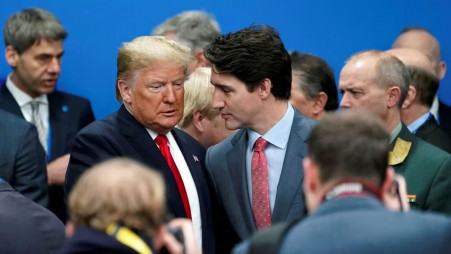Canada’s long beleaguered leader Justin Trudeau is finally on his way out. The reason: He is not able to face his own party lawmakers. On 6th Jan, Trudeau announced that he is resigning as the Liberal party leader. Trudeau will also step down as the Prime Minister of Canada, as soon as a new leader from his party is selected to take his place.
This decision has been a long time coming. Trudeau was ostracized by his own party members. His deputy PM Chrystia Freeland put in her papers on December 16 in a quite unceremonious fashion. She also resigned as finance minister and wrote a public letter blasting Trudeau’s approach to Trump’s sanction threat.
Struggling Trudeau
The economy is in doldrums, Canadians are struggling with high cost of living crisis, Liberal party’s poll prospects were also falling. A new survey by Nanos Research, taken over the holiday period, has the Conservative Party extending its lead into an election year.
Liberal Party caucus members from the provinces of Ontario and Quebec and the Atlantic region had already called for Trudeau to step down. Of the 153 party MPs in the House of Commons, over half have sought Trudeau’s resignation and that number could be approaching 100.
If reports hold, as a consequence the Liberal party will now choose an interim leader to replace Trudeau until this year’s elections. On the other hand, if Trudeau insists on keeping the PM chair to himself, he also may face a potential no confidence vote soon as the House of Commons returns on January 27. The opposition Conservative Party, and others, including the New Democratic Party (NDP), have publicly stated they will bring the government down.
All in all, even if Trudeau refuses to step down as PM this week, this won’t guarantee him any relief or a freeway.
Trudeau is currently politically so weak that he may agree to do something which was never an option for him. After all, he is a megalomaniac leader, who loves sticking to power. For instance, in October last year, Trudeau dismissed requests by Liberal lawmakers and declared he will lead the party into next elections. His pledge came after some 20 lawmakers asked him to step down as party leader. This dissent among the Liberal party kept growing bigger and louder but it all fell on Trudeau’s deaf ears.
What changed in the past 2 months?
It’s Trump’s election in the US that came as the last straw for Trudeau. Trump is still 15 days away from taking office but he has already deployed his tariff threats and trolling skills to petrify Trudeau and his crumbling regime.
From calling Canada to the 51st US state to calling Trudeau a governor, Trump sent out this message clearly that his regime would be brutally transactional and the US is the ultimate boss. His tariff threat then broke the backbone of the Trudeau regime. Trump has pledged to impose a 25% tariff on Canada. It will erode billions from Canada’s GDP, cost thousands of jobs and push the economy further under debt.
Trump and even Trudeau know that Canada’s economy literally stays afloat because of America. If he wants, Trump can literally implode the economy of Canada, whose 75 per cent exports are consumed by the US. Any increase in import duty by US would essentially kill the manufacturing sector in Canada.
Trump’s tariff threat is linked to Trudeau’s policies only, including immigration and drug trafficking. It was Trump’s war on Trudeau that first forced Freeland to resign and now the supreme leader is on his way out.
That’s how Trudeau became Trump’s first international casualty. And yes, there are many more to come.








